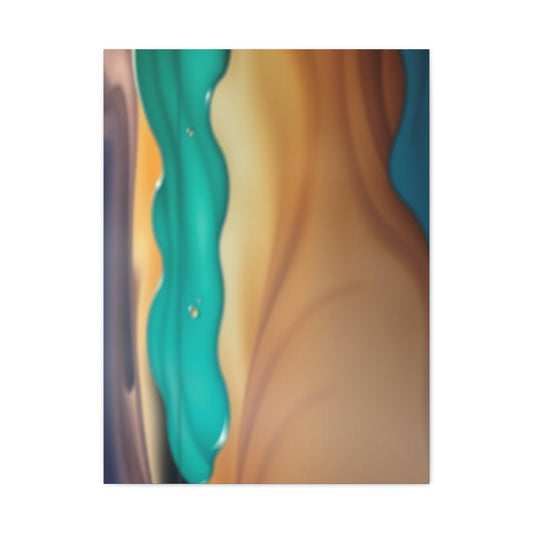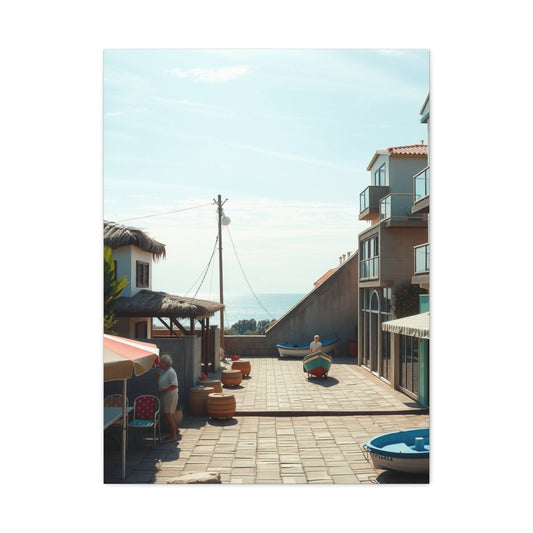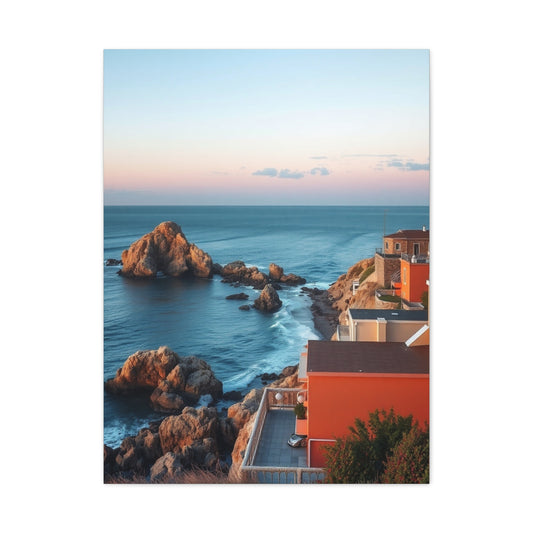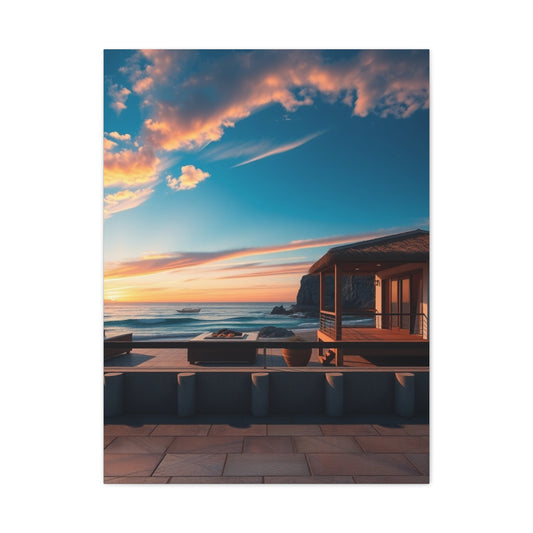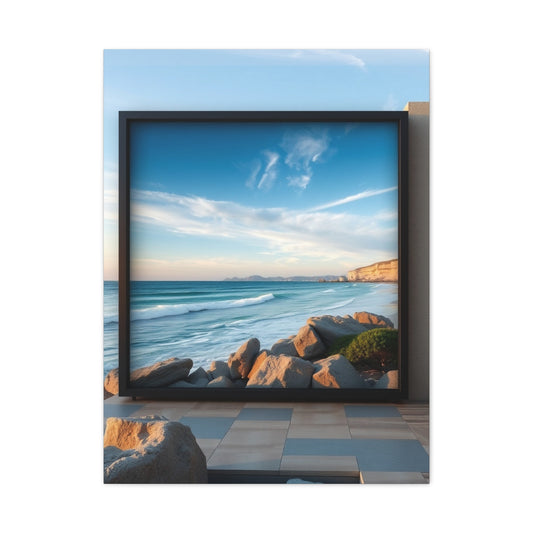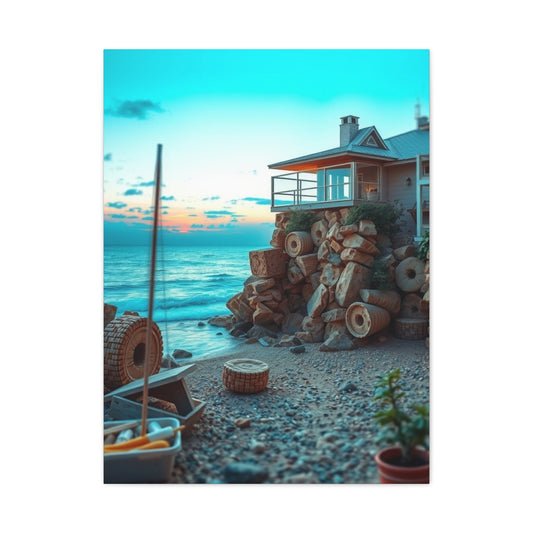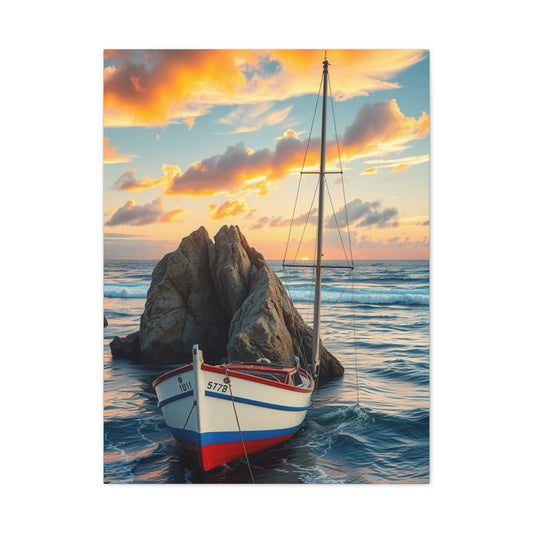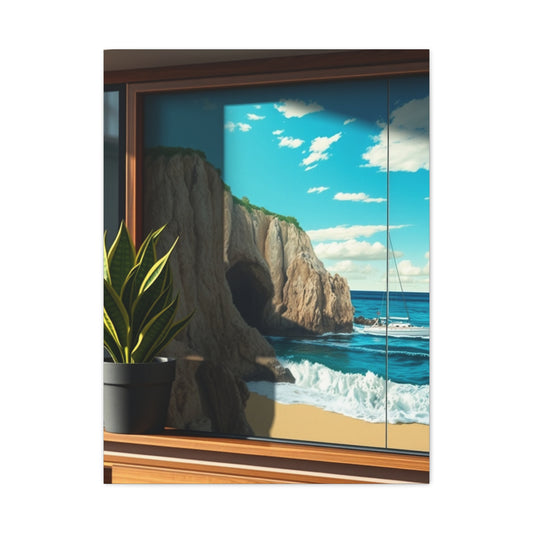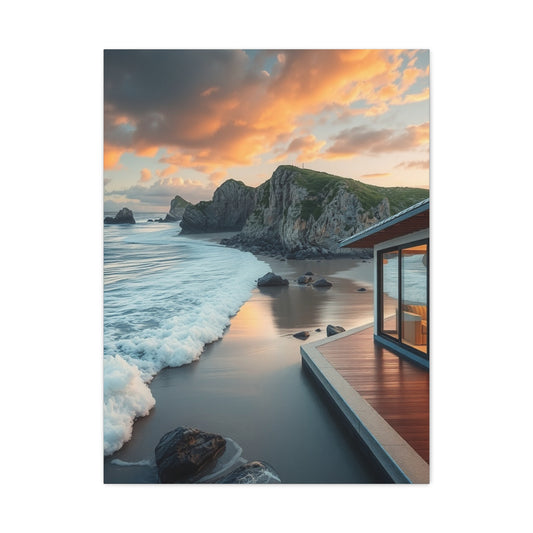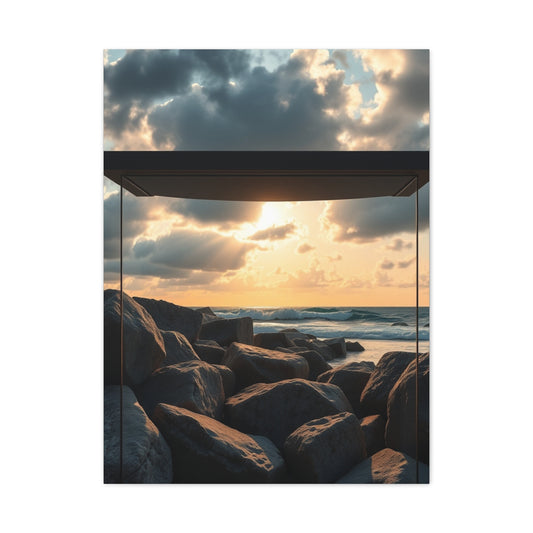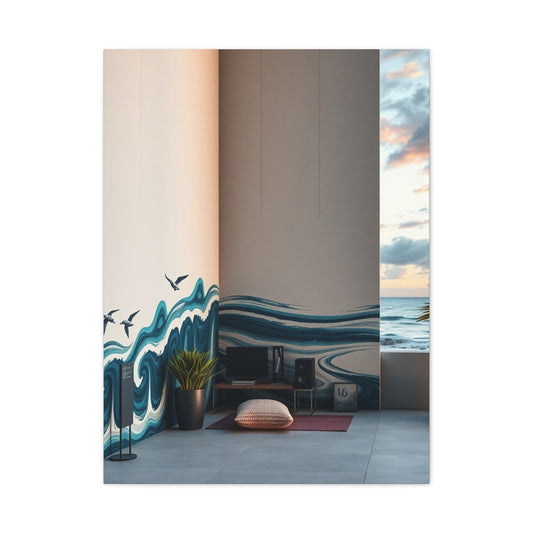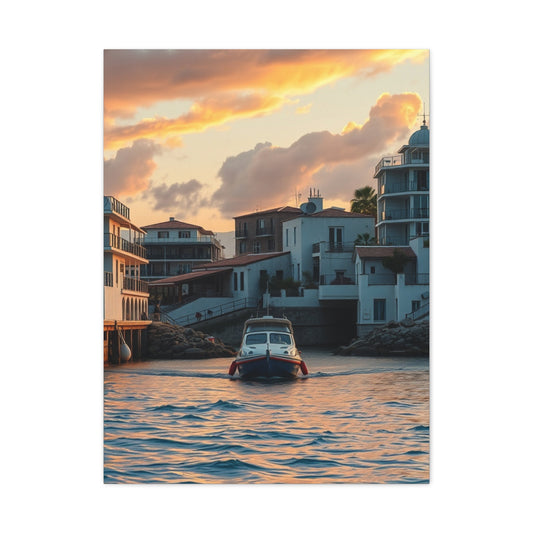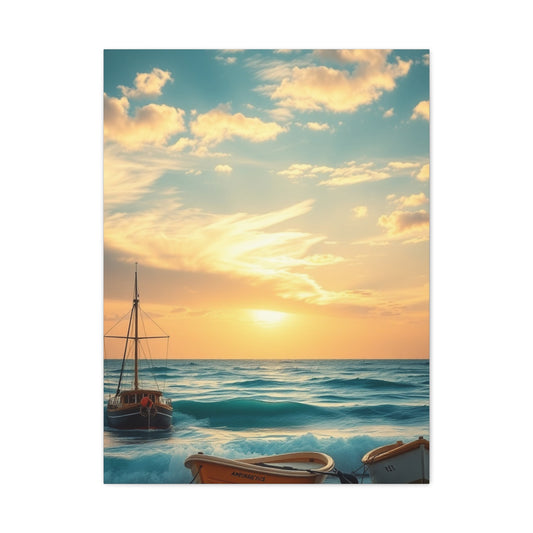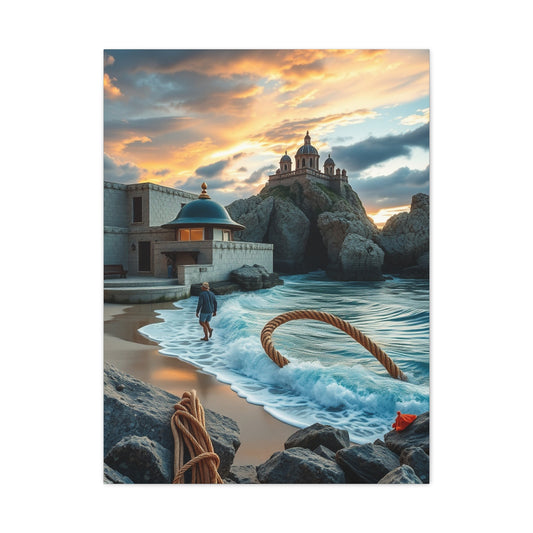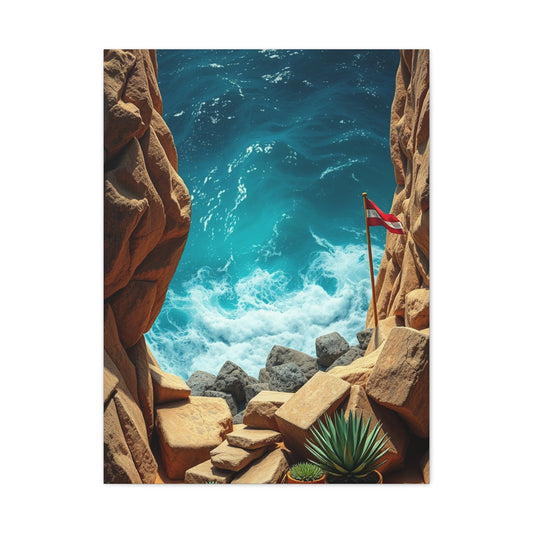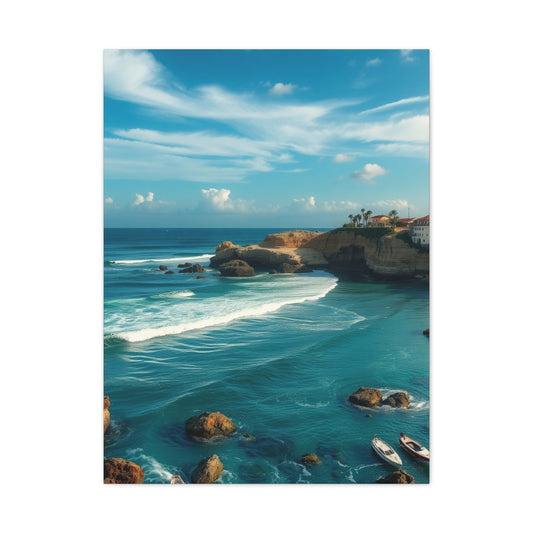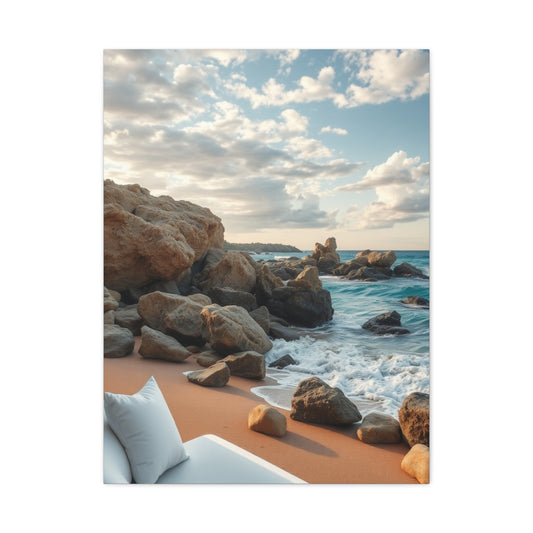How to Style Modern Coastal Wall Art for a Relaxed and Breezy Home Atmosphere
Creating a home that evokes the serenity of a seaside escape has long been a dream for those who adore the calming influence of coastal environments. Modern coastal wall decor plays an essential role in bringing this vision to life, weaving together elements of texture, color, and artwork that reflect the purity of the ocean and the warmth of sandy shores. Within interior design, wall art becomes more than a decorative addition; it transforms into a conduit of atmosphere, translating the tranquility of the sea into a tangible living experience. By infusing nautical-themed artwork, textured details, and coastal-inspired tones, homeowners can achieve a sanctuary that feels both contemporary and timeless.
The pursuit of modern coastal design is not about replicating a seaside cottage in literal terms, but rather curating a sophisticated balance between beach-inspired motifs and minimalist refinement. It is about cultivating walls that breathe lightness, showcasing imagery of ocean vistas, sailboats, or coral patterns, while also embracing materials that hint at nature’s raw beauty. When done thoughtfully, modern coastal wall decor transcends simple ornamentation, turning every surface into an expression of seaside tranquility.
Historical Background
The roots of coastal-inspired wall decor can be traced back centuries, when maritime exploration shaped art, architecture, and interior design across seafaring nations. Sailors often returned from voyages with keepsakes—maps, ship wheels, seashells, and exotic artworks—that found places on walls, bringing distant horizons into their homes. In Mediterranean regions, whitewashed walls adorned with oceanic frescoes conveyed both spiritual reverence and daily connection to the sea. In Northern Europe, coastal cottages often featured simple wooden carvings and seafaring emblems as tokens of livelihood.
Over time, these maritime tokens evolved into decorative traditions. By the eighteenth and nineteenth centuries, nautical paintings depicting naval triumphs, lighthouses, and stormy seas became prized forms of wall art in coastal towns. They served not only as visual narratives of maritime history but also as cherished symbols of resilience and aspiration. The twentieth century introduced a shift, where coastal aesthetics blended with modern design movements. Scandinavian minimalism embraced natural light and airy color palettes, often combined with seaside imagery, creating early blueprints of what we now call modern coastal interiors.
Today’s coastal wall decor is a culmination of these traditions, infused with contemporary sensibilities. It blends nostalgia for seafaring heritage with the simplicity of modern design, offering homeowners a refined way to celebrate the timeless bond between humans and the sea.
Core Concepts and Foundations
At the heart of modern coastal wall decor lies a philosophy rooted in three essential principles: tranquility, authenticity, and harmony with nature. These foundations ensure that the design does not simply imitate the coast but channels its essence in a sophisticated manner.
Tranquility is achieved through soothing palettes reminiscent of seafoam, shells, driftwood, and sunlight reflected on water. Walls are envisioned as canvases of calm, where every hue encourages a sense of balance. Authenticity emerges in the choice of materials—woven fibers, reclaimed wood, natural stone, and artisanal textiles that echo organic beauty. These tactile elements create walls that feel lived-in yet fresh, exuding sincerity rather than artificiality.
Harmony with nature ties all components together, ensuring that every artwork or accessory resonates with ecological sensibilities. This is why nautical-themed wall art often emphasizes subtle lines, soft horizons, and balanced compositions rather than overwhelming imagery. Mirrors framed with natural timber or rattan, along with macramé wall hangings and woven designs, support the idea of interconnectedness with the elements.
Together, these principles establish the foundation for a modern coastal aesthetic where walls act as silent storytellers, reflecting both personal memories of the sea and universal themes of peace and renewal.
Types and Categories
Modern coastal wall decor offers a wide array of categories that allow homeowners to personalize their living spaces while staying true to the overarching aesthetic. Nautical-themed artwork remains one of the most celebrated, ranging from serene depictions of lighthouses to abstract interpretations of waves and currents. These works balance adventure with serenity, capturing both the grandeur and subtlety of oceanic life.
Textured wall pieces, such as woven macramé hangings, driftwood sculptures, or carved coral motifs, introduce depth and tactile intrigue. These designs break away from flat surfaces, ensuring that walls embody a sense of dimension and movement. Another category lies in functional yet decorative elements such as reclaimed wooden shelves or hooks fashioned from nautical metals, which not only serve practical roles but also embody the coastal aesthetic.
Color-inspired wall treatments also deserve mention. Painted murals with soft gradients that mimic sunrise over the sea, or wallpaper with delicate shell or seaweed motifs, create immersive experiences. Mirrors represent yet another vital category. When strategically placed, they expand space while reflecting light in ways reminiscent of the sun dancing on the ocean’s surface. Their frames—whether rope-bound, driftwood-crafted, or seashell-inlaid—further enforce the maritime theme.
Lastly, personal touches such as framed travel photographs from beach holidays or locally crafted artwork offer an intimate category of decor. These pieces embody individuality, ensuring that coastal decor feels personal rather than generic, transforming walls into living memoirs.
Practical Applications
Applying modern coastal wall decor in daily living spaces requires thoughtful integration that balances beauty with usability. In living rooms, large-scale wall art portraying vast seascapes can serve as a central focal point, drawing the eye and setting the tone of serenity. Complementing this, woven wall hangings or textured accents add warmth without overwhelming the senses. Bedrooms, often considered sanctuaries, benefit from softer nautical-inspired art—think tranquil watercolor seascapes above the headboard, coupled with mirrors framed in natural fibers that reflect morning light.
For hallways or transitional spaces, smaller framed artworks of sailboats or coral studies can guide the eye, much like waypoints in a coastal journey. In dining areas, wall-mounted shelves made of reclaimed driftwood can display seashell collections, artisanal ceramics, or travel memorabilia, fusing functionality with aesthetic delight. Even bathrooms can embrace this design ethos, with mirrors edged in weathered wood and wall art featuring minimalist ocean sketches that enhance the spa-like ambiance.
The key to practical application is restraint. A well-curated selection of pieces ensures that walls breathe rather than suffocate, maintaining the airy, open essence of coastal living. Layering textures, balancing artwork with negative space, and ensuring natural light interplay are techniques that elevate the experience. When applied with sensitivity, modern coastal wall decor becomes an immersive environment where every glance reaffirms the calmness of seaside living.
Techniques and Methods
Designing a living space inspired by the coast requires both artistic intuition and deliberate technique. Modern coastal wall decor thrives on the harmony between subtlety and statement, demanding a balance of visual weight, texture, and spatial rhythm. One of the most effective methods is layering. By combining a primary focal point such as a large seascape painting with supporting accents like macramé hangings or woven rattan panels, the wall becomes a dynamic yet soothing surface. Layering also involves the thoughtful interplay of negative space, allowing the eye to rest between elements and preventing visual congestion.
Another technique lies in curating a palette that echoes the nuances of the ocean. Instead of flat tones, designers often employ gradients that replicate the shifting colors of waves or the glow of sunset across sand. This can be achieved through ombré wall treatments, soft watercolor-inspired murals, or even a series of coordinated artworks that transition in tone. Mirrors serve as another strategic method, not only for amplifying light but for visually extending the depth of a room. When aligned with windows, they capture fleeting moments of sunlight, emulating the shimmer of water.
Texture is perhaps the most tactile method of evoking coastal tranquility. Techniques include incorporating woven wall baskets, driftwood installations, and handcrafted fiber art that emulate organic irregularity. The goal is not perfection but authenticity—pieces that carry the imprint of natural processes. Designers also favor asymmetry, echoing the randomness of nature. An arrangement of varied frame sizes, slightly staggered, can mirror the scatter of seashells along a shoreline. By mastering these methods, one crafts an interior that speaks not only of the coast but of a life attuned to its rhythms.
Challenges and Common Mistakes
While modern coastal wall decor offers a path to serenity, it also presents challenges that can easily undermine the intended effect. One of the most common mistakes is overindulgence. It is tempting to fill every wall with nautical symbols, seashell prints, and beach memorabilia, but this risks creating a kitsch aesthetic rather than a refined coastal atmosphere. The essence of modern design lies in restraint, and too much ornamentation can drown the serenity one seeks to evoke.
Another frequent error is relying on artificial materials that mimic coastal textures without embodying their authenticity. Plastic imitations of driftwood, resin-based coral sculptures, or factory-produced nautical motifs often feel contrived, lacking the soulful imperfection of organic materials. Such choices can inadvertently create a theme-park quality, detracting from the elegance of modern coastal interiors.
Color misuse is another pitfall. While coastal design thrives on soft blues, whites, and sandy neutrals, using overly saturated or mismatched tones can disrupt harmony. Harsh navy, stark turquoise, or overly bright yellows may overpower the subtle sophistication that defines the style. Poor scale is yet another challenge. Hanging a small piece of artwork on a large expanse of wall without complementary elements leaves the space feeling sparse, while oversized artwork in a compact room can overwhelm the senses.
Lighting errors also surface frequently. Coastal decor depends heavily on natural light, and failing to align mirrors or reflective wall pieces with windows reduces the airy, open feel. Equally problematic is inadequate artificial lighting that casts shadows, obscuring textures and artwork. To avoid these mistakes, one must embrace patience, thoughtful curation, and a willingness to let simplicity guide the process.
Trends and Future Outlook
Modern coastal wall decor continues to evolve, guided by shifts in lifestyle, environmental consciousness, and artistic exploration. A rising trend is the use of sustainable and reclaimed materials, reflecting a global movement toward eco-conscious living. Walls adorned with driftwood sculptures salvaged from shorelines or reclaimed timber shelves celebrate both beauty and responsibility. This trend not only reduces environmental impact but also enriches interiors with pieces that carry history and character.
Minimalist interpretations of coastal design are also gaining momentum. Rather than overt nautical motifs, the future leans toward abstraction—artworks that capture the fluidity of waves through brushstrokes, or textures that suggest coral reefs without literal representation. This allows coastal-inspired interiors to adapt seamlessly to urban apartments and contemporary homes far from the shore.
Technology is subtly influencing trends as well. Digital wall art frames, capable of displaying rotating ocean-inspired visuals, are being embraced by tech-savvy homeowners who desire flexibility. These dynamic canvases can shift from tranquil sunrise seascapes in the morning to moonlit harbors at night, aligning ambiance with mood.
Future outlook also suggests a deeper integration of cultural influences. Coastal wall decor may draw inspiration from diverse maritime traditions—from Japanese woodblock prints of waves to Mediterranean tilework echoing the sea. Such inclusivity expands the language of coastal design, ensuring it remains versatile and globally resonant.
Perhaps the most enduring outlook is the pursuit of serenity in an increasingly chaotic world. As urban life accelerates, the demand for interiors that mimic the peace of the shore will only intensify. Modern coastal wall decor will continue to embody this timeless desire, refining its methods while retaining its essence of calm.
Expert Insights
Designers and artists who specialize in coastal-inspired interiors emphasize the importance of intentionality. Many note that successful coastal wall decor is not achieved by purchasing ready-made sets of themed decorations, but by curating pieces that resonate personally. For instance, a single large painting by a local artist may convey more depth and authenticity than a cluster of mass-produced nautical prints. Experts recommend sourcing artworks that align with natural palettes and carry emotional resonance, as these elevate interiors beyond trend-based styling.
Interior stylists also advise paying close attention to proportion and balance. Renowned designers often describe walls as canvases of rhythm, where each element contributes to a symphony of light, texture, and space. They stress the importance of allowing negative space to breathe, ensuring that walls do not appear cluttered. Personal photographs from coastal travels, when framed elegantly and interspersed with professional art, add intimacy without sacrificing refinement.
Experts also highlight the growing influence of craftsmanship. Handwoven textiles, artisanal ceramics mounted as wall pieces, and driftwood sculptures are celebrated not only for their beauty but for their narrative quality. Such works tell stories of artisans, of natural processes, and of places where land meets sea. Incorporating these into coastal wall decor ensures a timeless connection to authenticity.
The consensus among seasoned decorators is that modern coastal wall decor should be an evolving dialogue between the homeowner and the space. It is not a static theme to be completed, but an organic composition that shifts with seasons, moods, and experiences. This perspective underscores that the true art of coastal interiors lies not merely in aesthetic arrangement but in cultivating a living sanctuary that continues to inspire calm year after year.
The world of wall art has always mirrored the cultural currents of society, shifting in response to design philosophies, artistic innovations, and lifestyle preferences. As modern interiors continue to evolve, the role of wall art is no longer limited to decorative enhancement but has become an essential medium for self-expression and ambiance. Today’s homeowners and designers look toward emerging trends in wall art not only for visual enrichment but also for the ability to transform spaces into sanctuaries of meaning, creativity, and style.
These emerging trends span across materials, themes, and formats, revealing a future where wall art is as fluid as the environments it inhabits. Step-by-step approaches help guide the process, enabling enthusiasts to navigate between abstract creativity, sustainable practices, and technological integration without losing touch with timeless principles of balance and refinement.
Step 1: Understanding the Evolution of Wall Art
The first step in embracing new trends is to recognize how wall art has evolved across decades. Historically, wall art was primarily associated with classical paintings, portraits, and traditional landscapes. Over time, however, interiors demanded greater flexibility, and new forms of wall decoration—murals, abstract compositions, photography, and digital prints—began to take precedence.
The modern movement introduced minimalism and abstraction, offering cleaner lines and subdued palettes, while contemporary approaches have leaned into personalization, sustainability, and experimental materials. By studying this evolution, one develops an eye for recognizing how present trends are rooted in the past yet shaped by modern sensibilities.
Step 2: Identifying Materials and Media of the Future
Wall art trends today are heavily influenced by innovative materials and mediums. Artists and designers are experimenting with reclaimed wood, recycled metal, woven fibers, natural stone, and organic textiles. This growing preference for sustainable elements reflects both ecological responsibility and a desire for authenticity.
Digital media are equally impactful. Electronic frames capable of rotating high-resolution images, interactive LED-based artworks, and projection mapping are becoming more prominent in modern interiors. Such innovations allow homeowners to curate dynamic walls that adapt to seasons, moods, or specific occasions.
When choosing materials, the step-by-step method involves balancing durability, aesthetic compatibility, and ethical sourcing. For instance, reclaimed driftwood frames pair beautifully with coastal-inspired spaces, while sculptural metal installations can complement modern industrial lofts. These material choices define not only the visual impression but also the environmental consciousness of the design.
Step 3: Exploring Styles and Aesthetic Directions
Trends in wall art emphasize an array of styles, from bold maximalist compositions to serene minimalist canvases. One growing aesthetic is biophilic art, which integrates natural motifs such as foliage, botanical sketches, and landscapes that echo humanity’s deep-rooted connection to nature. Another thriving direction is abstract geometry, where angular designs and fragmented compositions evoke rhythm and movement.
Cultural storytelling has also risen as a trend. Artworks that reference heritage patterns, traditional crafts, or global narratives bring depth to interiors, transforming walls into conversations between past and present. Personalization is equally essential; customized murals or commissioned pieces ensure individuality and distinction in spaces that might otherwise feel standardized.
Following this step in a guide means asking: which style resonates most with the emotions and atmosphere one desires for the room? By identifying this, the homeowner ensures that wall art aligns seamlessly with overall interior narratives.
Step 4: Integrating Technology with Wall Art
The role of technology in emerging trends cannot be overlooked. Smart frames, augmented reality projections, and dynamic lighting effects are beginning to redefine how art interacts with its environment. Rather than static pieces, modern wall art can shift in tone, adjust brightness, or even respond to external triggers such as music or movement.
For those seeking step-by-step integration, start with small innovations such as digital displays capable of exhibiting multiple artworks. Over time, larger immersive techniques like projection mapping or light-responsive installations can be explored. These methods transform walls into living, breathing surfaces where art evolves continuously, redefining the boundaries between traditional decor and digital expression.
Step 5: Balancing Trends with Timelessness
One of the greatest challenges in following trends lies in ensuring they do not render interiors obsolete within a few years. The solution is to balance emerging tendencies with timeless qualities. Neutral palettes, elegant framing, and high-quality materials can provide a classic foundation upon which experimental trends rest.
For example, a timeless seascape may serve as an anchor piece, while surrounding digital or abstract artworks introduce contemporary flair. This layered approach ensures that walls retain relevance and sophistication even as artistic trends shift. The step-by-step mindset here involves evaluating each piece not only for its immediate appeal but also for its potential longevity within the evolving interior landscape.
Step 6: Practical Applications in Different Spaces
Each room in a home offers unique opportunities for implementing emerging wall art trends. Living rooms benefit from expansive canvases or dynamic digital installations that command attention and define ambiance. Bedrooms, by contrast, favor subtler pieces—soothing abstract paintings or nature-inspired prints that promote restfulness.
Dining areas thrive with conversational art, whether it be culturally inspired murals or sculptural installations that spark dialogue. Hallways and transitional spaces offer the chance to experiment with gallery walls, where eclectic collections of photographs, sketches, or digital mini-frames create narrative journeys. Even workspaces within the home can incorporate motivational abstract art or interactive displays, enhancing creativity and productivity.
A step-by-step approach means tailoring wall art not only to spatial scale but also to the emotional purpose of the room, ensuring that the trend adopted complements the function it supports.
Step 7: Avoiding Pitfalls in Trend Adoption
Embracing emerging wall art trends requires careful navigation to avoid common mistakes. One pitfall is over-saturation—filling walls with every trending idea at once, which diminishes coherence. Another is ignoring personal resonance in favor of popularity; a wall covered in fashionable designs that hold no personal meaning risks feeling impersonal and transient.
Budgetary pitfalls also arise when investing in fleeting technology or low-quality reproductions. The solution is to prioritize craftsmanship and thoughtful curation over quantity. Step-by-step refinement ensures that each chosen artwork enhances the space rather than merely follows a trend.
Step 8: Anticipating Future Directions
The future of wall art trends points toward deeper integration of sustainability, personalization, and interactivity. Eco-conscious innovations such as biodegradable frames or plant-based dyes will likely dominate the market. Personalized commissions through digital platforms will make unique, tailor-made artwork accessible to a broader audience. Interactive pieces will continue to evolve, with walls that respond to gestures, voices, or even biometric data, creating highly personalized environments.
For those adopting trends step by step, staying attuned to these possibilities ensures that interiors remain forward-looking without abandoning core design principles.
Emerging trends in wall art invite homeowners and designers alike to reimagine walls as dynamic canvases of creativity and reflection. Through a step-by-step approach, one can embrace new materials, styles, and technologies while maintaining a balanced harmony between timeless design and contemporary experimentation. Each choice contributes to a layered narrative, where walls are no longer passive surfaces but active participants in shaping ambiance, identity, and cultural resonance.
Advanced Approaches to Wall Art Integration
As design evolves, advanced approaches to wall art extend beyond surface embellishment and move toward holistic integration within interiors. Walls are no longer mere backdrops but canvases that shape the rhythm and tone of a living environment. The modern home, whether urban apartment or coastal retreat, benefits from thoughtful applications of wall art that fuse technology, craftsmanship, and spatial psychology. Designers now experiment with hybrid methods, blending large-scale murals with digital layers, or juxtaposing traditional hand-painted motifs with sculptural installations that cast shadows and interact with light. This progressive thinking transforms ordinary surfaces into immersive experiences.
Another advanced technique involves multisensory engagement. Art is increasingly designed to be not only seen but also felt through texture, hinted at through scent diffusers embedded within frames, or even accompanied by soundscapes that heighten atmosphere. In this sense, wall art evolves into an environment rather than an isolated object. The interplay of texture, dimension, and interactive elements ensures that each space resonates with character and vitality, offering homeowners a deeper bond with their surroundings.
Cultural and Symbolic Dimensions of Wall Art
Art adorning walls often carries meanings that transcend decorative intent, embodying cultural memory, personal stories, and symbolic resonance. In many traditions, wall art has long served as a vessel of identity—ancient frescoes in Mediterranean villas depicted mythological journeys, while Japanese ink paintings conveyed philosophies of harmony and impermanence. Modern design reinterprets these symbolic functions, allowing walls to act as narrators of heritage, values, and aspirations.
The cultural dimension is particularly visible in the fusion of global motifs within contemporary interiors. Moroccan geometric designs, Indian mandala-inspired compositions, or African tribal patterns now find their way into urban spaces, creating cross-cultural dialogues. Homeowners often select these works not only for visual appeal but for the stories they embody, transforming walls into cultural mosaics that honor shared humanity.
Symbolism also emerges in subtler ways. Abstract art inspired by ocean currents may symbolize resilience and fluidity, while geometric precision can represent order and clarity. By acknowledging these dimensions, walls become more than aesthetic planes; they evolve into reflections of personal philosophy and collective consciousness.
Emotional and Psychological Impact of Wall Art
Beyond its aesthetic presence, wall art exerts a profound psychological influence on mood, perception, and well-being. Research in environmental psychology suggests that visual environments deeply affect stress levels, creativity, and even productivity. Art depicting tranquil seascapes or serene abstract forms has been shown to evoke relaxation, while dynamic compositions stimulate thought and imagination.
In the home, these effects manifest in subtle yet powerful ways. A bedroom adorned with calming, nature-inspired prints fosters restfulness, while a home office displaying bold abstract forms may invigorate focus and drive. The choice of color and form directly interacts with human emotion—soft blues and pale neutrals soothe, while warm tones provide comfort and familiarity.
The step of curating wall art becomes, therefore, not only a design decision but an investment in mental and emotional wellness. The most successful interiors are those that harmonize with the inhabitants’ inner rhythms, offering reassurance during moments of quiet reflection and inspiration during times of activity.
Wall Art in Public and Shared Spaces
While residential interiors are a natural setting for wall art, public and shared spaces equally reveal its significance. Restaurants, offices, galleries, and hotels use wall art to define atmosphere and communicate identity. A boutique hotel may employ large-scale murals to tell the story of its location, while a workplace might use motivational abstract art to foster innovation and collaboration.
Urban environments are witnessing the rise of monumental wall art through street murals and installations. These public works not only beautify but also challenge, provoke thought, and create collective identity within communities. Such examples highlight the versatile role of wall art beyond private ownership, illustrating its power to unify individuals through shared aesthetic experiences.
In shared domestic spaces such as family living rooms or communal dining areas, wall art often acts as a unifier, blending the tastes of different household members while reflecting collective values. The chosen pieces become touchstones of memory and belonging, contributing to cohesion and identity within the household.
Sustainability and Ethical Considerations
A growing dimension in wall art trends is sustainability. Conscious homeowners and designers increasingly seek pieces that honor ecological balance, whether through recycled materials, low-impact dyes, or collaborations with artists who prioritize environmentally mindful methods. Driftwood sculptures, artworks painted on reclaimed canvases, and textiles woven from organic fibers all represent sustainable pathways that enrich both interiors and ethical living.
The ethical consideration extends beyond materials to issues of cultural respect and fair trade. As global motifs inspire contemporary design, it becomes crucial to support artisans authentically and to avoid superficial appropriation. Choosing artworks that are either directly sourced from craftspeople or produced in partnership with local communities ensures that wall art enriches not only interiors but also the lives of its creators.
This mindful approach imbues walls with moral resonance, ensuring that beauty and conscience coexist harmoniously.
Personalization and Narrative Building
Modern wall art has shifted from being a decorative afterthought to a vital storytelling medium, allowing homeowners to weave narratives that reflect individuality, heritage, and aspiration. Personalization ensures that walls move beyond anonymity, becoming distinctive canvases infused with emotion and meaning. Every home possesses a story, and through wall art, that story is articulated in visual language that transcends words.
Photographs of family milestones remain among the most poignant expressions of this trend. Framed images of childhood, weddings, travels, or generational gatherings infuse interiors with intimacy, transforming spaces into living archives of memory. Rather than functioning as static displays, these arrangements often form gallery walls that evolve with time, expanding as new memories are created. Commissioned artworks, meanwhile, add another layer of personalization. A painting inspired by a cherished vacation or a mural designed to encapsulate personal philosophy offers uniqueness that no off-the-shelf piece can replicate.
Custom murals are particularly powerful in narrative building. Whether abstract compositions evoking ocean horizons or figurative designs depicting symbolic motifs, they bring cohesion and individuality into homes. In larger interiors, murals act as immersive landscapes that guide the imagination, while in smaller spaces, even a single customized illustration can transform the atmosphere.
Personalization also operates across multiple rooms, crafting continuity and thematic cohesion. A series of abstract seascapes in varying shades of blue, weaving through the living room, hallway, and bedroom, binds spaces into one unified journey. Each wall becomes a chapter in a broader story, contributing to the unfolding tale of a household. This method ensures that art is not confined to isolated rooms but contributes to the overall identity of a home.
Narrative building extends beyond family history into personal passions and philosophies. For some, art may reflect spiritual exploration, while for others it embodies cultural pride or environmental advocacy. A homeowner might curate walls with indigenous textile art to honor heritage, or commission a sculptural piece using reclaimed driftwood as a testament to ecological mindfulness. In this way, wall art becomes an intimate dialogue between personal values and aesthetic sensibilities.
The result of this narrative-driven personalization is that no two walls are ever alike. Each home, regardless of size or design style, gains a distinctive aura that is difficult to replicate. Walls cease to be blank boundaries and instead emerge as guardians of memory and expression, breathing vitality into the domestic environment.
Technological Convergence and the Future of Walls
The convergence of technology with wall art is radically reshaping the future of interior design, turning passive surfaces into dynamic, adaptive ecosystems. Where once art was fixed and unchanging, innovations are now creating walls that transform in rhythm with human needs, moods, and environments. This new frontier redefines the very idea of what wall art can be.
Smart art frames represent the first wave of this revolution. These digital canvases allow homeowners to display curated collections that shift throughout the day, offering the flexibility to showcase a sunrise seascape in the morning, a minimalist abstract at midday, and a calming nightscape by evening. Beyond mere convenience, these frames introduce dynamism and mood sensitivity into interiors, ensuring that walls remain vibrant and alive.
Augmented reality projections extend this transformation further. With AR technologies, walls can evolve into interactive storyboards, displaying layered images, animations, or even immersive environments that respond to human interaction. Imagine walls shifting from a calm ocean horizon during meditation to a burst of abstract colors during social gatherings. This adaptability ensures that interiors respond fluidly to lifestyle rhythms.
The future hints at even more radical possibilities, where walls themselves may serve as interactive displays. Surfaces coated with smart materials could respond to touch, movement, or voice, enabling homeowners to alter aesthetics in real time. A single gesture might transform a blank wall into a forest mural, a geometric composition, or even a living data visualization.
Technology is also expected to merge with sustainability in ways previously unimaginable. Bioluminescent materials inspired by natural organisms may one day create glowing murals that require no electricity, while solar-powered installations could harness light by day and radiate patterns by night. Interactive walls linked to environmental data may shift in color or form depending on air quality, temperature, or natural cycles, allowing interiors to echo the state of the world outside.
These innovations blur the boundaries between science, design, and ecology. They transform walls into responsive environments rather than static boundaries, allowing them to adapt in harmony with the inhabitants and their surroundings. For homeowners, this convergence offers unprecedented freedom: walls can now reflect personal expression, seasonal moods, ecological awareness, or cultural narratives, all within the same space.
The technological evolution of wall art underscores a broader truth—art is no longer confined to permanence but is instead becoming an evolving dialogue between human creativity and technological advancement. As this frontier unfolds, walls will increasingly act as living entities, shaping ambiance, identity, and experience in ways that surpass traditional imagination.
Conclusion
The journey through modern wall art reveals far more than decorative possibilities. It uncovers an intricate landscape where culture, psychology, sustainability, and technology converge. Walls, once regarded as blank canvases awaiting embellishment, now emerge as vital storytellers, shaping atmospheres, reflecting identities, and fostering well-being.
As emerging trends continue to influence the field, the step-by-step approach to wall art ensures that each choice remains deliberate and resonant. Advanced techniques highlight the value of multisensory engagement, while cultural and symbolic dimensions remind us of art’s timeless role in shaping meaning. The psychological influence reinforces its power over mood and perception, and sustainability grounds it in ethical responsibility. Personalization ensures individuality, and technological convergence hints at a future of endless innovation.
Ultimately, the enduring essence of wall art lies in its ability to marry timeless beauty with contemporary relevance. It transforms houses into havens, communities into shared narratives, and ordinary walls into extraordinary experiences. In this evolving dialogue between tradition and innovation, wall art stands as a living testament to humanity’s quest for expression, serenity, and connection.


